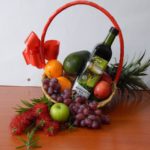 Kenya is home to competitive fresh produce that has enriched the diversity of its agricultural exports over the years. Excluding tea and coffee, which are substantial income earners, horticultural produce has great potential in export diversification. Vegetables contribute 35 percent of the total yearly exports. They include legumes, traditional vegetables and Asian vegetables. Cut flowers, on the other hand, provide 60 percent of the yearly horticultural sales overseas according to the Export Processing Council (EPC) data. This leaves a 15 percent gap that value added products from fruits and vegetables can fill.
Kenya is home to competitive fresh produce that has enriched the diversity of its agricultural exports over the years. Excluding tea and coffee, which are substantial income earners, horticultural produce has great potential in export diversification. Vegetables contribute 35 percent of the total yearly exports. They include legumes, traditional vegetables and Asian vegetables. Cut flowers, on the other hand, provide 60 percent of the yearly horticultural sales overseas according to the Export Processing Council (EPC) data. This leaves a 15 percent gap that value added products from fruits and vegetables can fill.
Below is a look at three value added fruits with illustrations of their current levels of processing capacities in Kenya.
Pineapple: a perennial export from major plantations in central Kenya and the Rift Valley, pineapples thrive in medium rainfall conditions of between 600 and 1500 millimeters per year. The solid matter than indicates the brix level is usually best when the crop grows at low altitude areas. This also reduces the acidity and increases the processing viability. The most canned variety is the Sweet Cayenne which thrives in most areas including the Thika region which supplies much of the local fruit.
Smallholder growers of the fruit provide the bulk of the unprocessed fruits, and with the coming of new factories this may change. In 2012, the government commissioned the construction of a $0.6 million factory in Bureti in the South Rift. The factory’s capacity would be fifty six thousand metric tons. The region produces an equal amount of pineapple fruit, which reflects the 2010 sales margins. At the Coast, a A Hola-based mango processing plant that cost KSH. 120 million would process pineapples during the offseason of mangoes. In large-scale terms, Del Monte, on the other hand, a planter based in Thika processes its own fruits and supplies 50 percent of the local demands. With the building of new factories, the processing capacity of the country will continuously grow.
Mango: the mango season in Kenya is throughout the year. For instance, the Coast has the fruit between November to January and then May to July. The Central region starts its supplies in November through March. This is succeeded by Eastern whose season starts December and continues through April. In Nyanza, mangos are available through the early parts of the year and then June and July. This means only September and November lack the mass-produced fruit.
Because of the high volume of the fruit, mango processing plants for value addition have sprouted around the country. Nairobi factories for juice, jam, confectionaries and even ice-cream with mango flavors have been around for decades. In the coast, a Tana River factory opened to serve ten thousand farmers in 2014. The fruit factory that has the capacity to produce 30MT daily has already improved mango post-harvest processing. There are less losses now as farmers sell their surplus at the factory for juice processing.
Orange: the citrus family of fruits including oranges, lemons and limes have also attracted juice and lemonade processing plants. The preference of these canned juices is as a result of a rising number of people with middle class tastes for healthy value added fruits. The main growing areas include Central Rift, such as Keiyo south, central Kenya and Mount Kenya regions, including Meru. The current production of juice in the country is from multipurpose fresh juice factories. These include Bidco at Ruiru near Nairobi and other small scale bottlers in Nairobi.
Thus, because value added products are now in appeal, there is a growing number of factories across the land for processing. Traditionally, the factories were meant to reduce fruit losses during post-harvesting. However, the growth of the local reseller market of health-conscious middle-class and a growing export market have meant value addition is here to stay.

